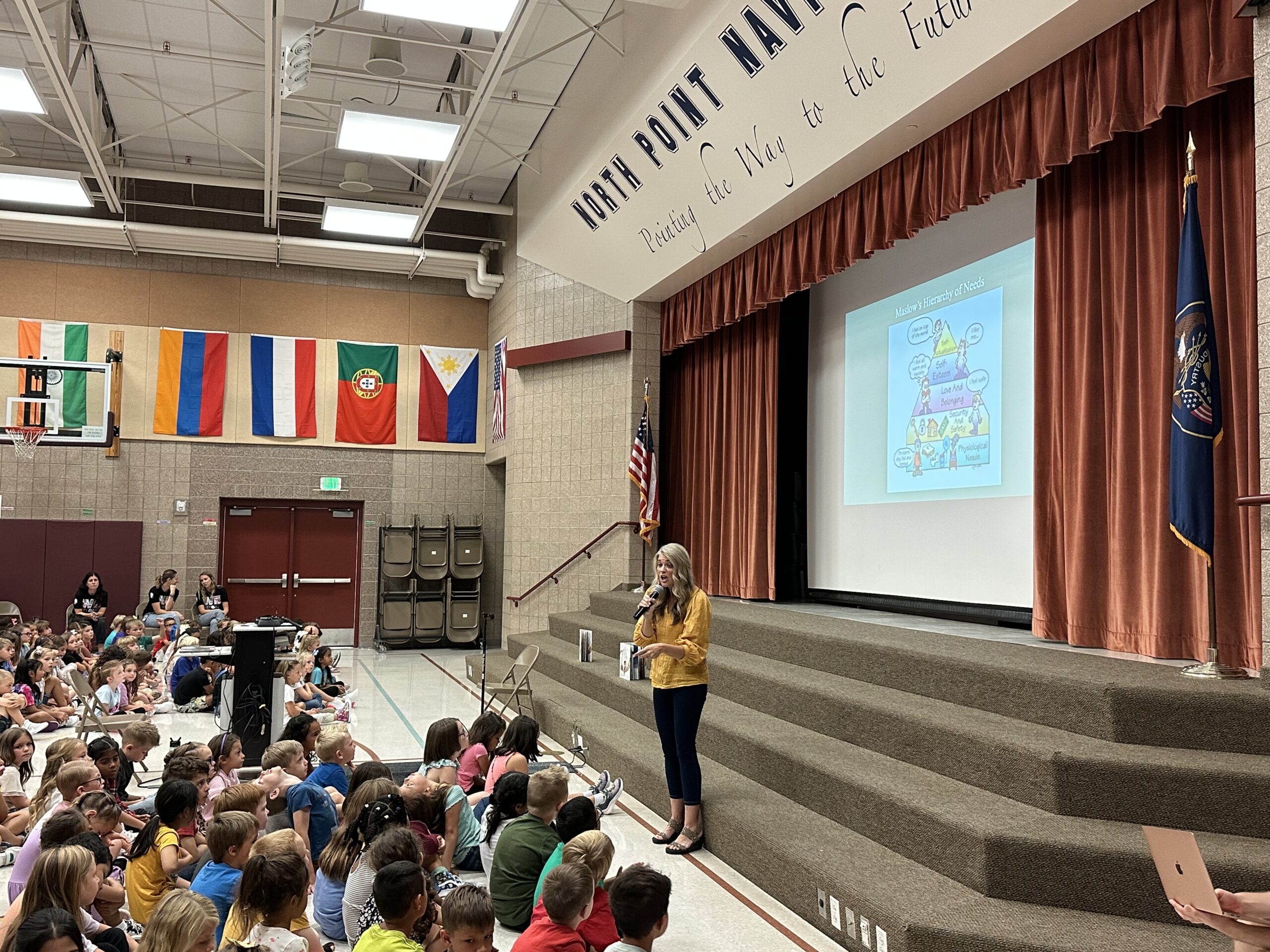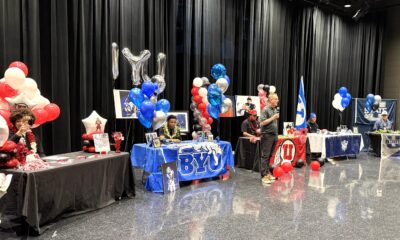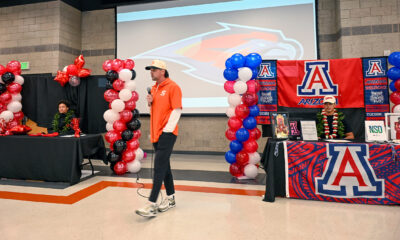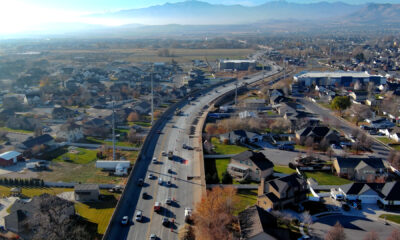Education
Lehi schools adapting to increase in non-native English speakers
Published
2 years agoon

Megan Wallgren | Lehi Free Press
Lehi’s population boom is bringing growing pains and unexpected opportunities for growth in Lehi schools. Among the challenges is a sharp increase in students who are non-native English speakers, known in Alpine School District as Multilingual Learners.
Teachers gather in a room at Viewpoint Middle School. A speaker stands and begins speaking in Chinese. The lesson continues for ten minutes before the meeting continues in English. It’s a training exercise for teachers designed to provide a feel for what it’s like to be a multilingual student, new to English, sitting in a classroom.
“It’s eye-opening,” said Viewpoint Middle School principal Aaron Barth. “It gives [teachers] empathy for what their students are going through.”
Since the fall of 2022, some Lehi schools have had multilingual learner populations (also known as English Language Learners or ELL students) more than double. Faculty and staff work to provide services for this relatively new group of students who join their student bodies, often in the middle of the school year, with little to no English skills and school experience.
Viewpoint’s mid-year count was 80 multilingual learners, a significant increase from the school’s opening year just two years ago. North Point Elementary has one of the city’s fastest-growing populations of multilingual learners. School started in August 2022 with five multilingual learners and 18 months later, finished in December 2023 with 93 multilingual students, nearly 10 percent of its student population. Dry Creek Elementary has also seen a sharp increase in its multilingual student population, from under 20 students at the beginning of the year to 60 mid-year. Multilingual students comprise around five percent of Dry Creek’s student population.
“It’s been kind of an eye-opener to help them,” said Dry Creek Principal Patrice Worlton. With district funding, they’ve hired a full-time aide who speaks Spanish. “We’re doing our best, and we will be more prepared next year.”
Other Lehi schools are also seeing increases, with lower rates. At mid-year, the Lehi High School cluster had 427 multilingual students (a cluster is a high school and all the elementary and middle schools that feed it). The Skyridge cluster has 289. Though growing, Lehi’s multilingual learner population is still relatively small compared to some clusters in the District. The Mountainview cluster has the District’s largest population of multilingual learners, with 1,265 students.
“Other areas in the district have already navigated this, but it’s new to us,” said Cassy Saxton, principal of North Point Elementary.
Many of North Point’s multilingual learners are asylum seekers or refugees from countries experiencing economic and social upheaval. “Some of them are coming from places where they haven’t been able to attend school for two or three years, so we have academic gaps along with language challenges,” said Saxton. “They left their country with what they had on their backs. They’ve been running, trying to relocate to a safe place.”
North Point has been very proactive in finding the tools and resources for the students and staff to be successful. They contacted the District for help and became one of 15 schools in an Alpine district pilot program to help multilingual learners.
Annya Becerra, Director of Student Educational Equity at Alpine School District, said schools in the pilot program work with an international consultant to create a school task force of teachers and staff focused on multilingual learners. “We want to create a team approach in supporting our students. It creates a culture at the school,” she said.
North Point has included three classroom teachers, the principal, a learning coach, and their librarian on their task force, along with the district representative. “It turned out to be really great timing,” Saxton said.
Spanish is the native language of most of Northpoint’s multilingual learners, including asylum seekers from Venezuela. When the influx of multilingual students began, fueled by new housing developments, Northpoint had no fluent Spanish speakers on its staff. By mid-year, they were able to add a paraeducator who spoke Spanish. This school year, they hired another.
North Point has multilingual students whose native languages include Spanish, Mongolian, Portuguese, Turkish, Tagalog, Korean, and a few African languages. There has been speculation that a refugee organization has been settling families in the area, but Saxton had no personal knowledge of any organization doing so. She said many multilingual people come because they moved in with their families already in the area.
Saxton is very proud of the North Point teachers and their rise to the occasion. “Learning how to reach those students has been a challenge for them. It’s been a whole mindset change, and they have been so welcoming. It’s hard to get new students on and off throughout the year. They’ve been amazing in taking on new students regardless of background.”
Saxton said many staff members use a district grant to pay for online training to teach multilingual learners. The training is a 29-hour program similar to getting an English Language Learning endorsement.
“The front office staff are doing an amazing job of hooking parents up with resources. A lot of times, they don’t have devices or internet in their homes. They [staffers] help with registration, school lunch, Skyward, all are new things no matter where you’re from,” said Saxton.
According to Becerra, the District supports integrated language acquisition at every level. This support includes access to videos, grade-level teaching resources, a curriculum for English language acquisition and literacy skills, and welcoming packages in ten languages. The District also receives supplemental funding from the state for higher-population schools to pay for programs and paraeducators.
Along with teacher training and hiring new multilingual staff, Lehi schools welcome these students in other ways to support them and unify student bodies.
“Innovation is taking place, and we’re seeing some great work,” said Becerra.
At Viewpoint, new multilingual learning students are paired with another student who speaks the same language to provide a tour of the school and help navigate classes. “It can be terrifying coming somewhere new where you don’t speak the language. “This pairing with other students] empowers students to help other students,” said Barth.
Viewpoint also arranged a tour of local college campuses for some of the school’s multilingual learning students. “We wanted them to see what next level education looks like and see their potential beyond just high school,” said Barth. Students also visited M-Tech to see opportunities available even in high school. “Many students said they had no idea these things were so close. What an opportunity to start opening their eyes to the vast opportunities out there,” Barth said.
Dry Creek is planning a parent outreach, kicking off with a dinner and classes for students and parents. “We need to do something to bridge the gap and make them feel welcome,” said Worlton. They have started a Hope Squad, and those students and the student council have taken a leadership role in helping new multilingual students feel supported and included despite the language barrier. “It’s been neat to see,” Worlton said.
North Point has chosen “We Belong” as its theme this year. It’s an acronym for belonging, empathy, listening, optimism, nurturing, kindness, and grit. Each month, the school focuses on a characteristic to bring students together and make them feel welcome. They started the year with an assembly where local author Gayle Holdman read her book, “The Piece That Is You.” The book explains how stained-glass art combines shapes and colors, which are pieced together to form a whole.
North Point has also expanded its library to include books in different languages. Saxton said teachers traveling out of the country have bought books in those places and languages to add to the collection. They have also started sending home all school communications in both English and Spanish. Their school gym is lined with flags from countries around the world.
The school administrators admire the multilingual learning students’ ability to adapt. “They have such resilience, and they are on it, and it’s so fun to see them grasp things and their eyes light up,” said Barth.
Becerra said, “If you provide multilingual learning students with support and an environment to thrive, they will step up. Kids are so resilient.”
Lehi’s schools will continue to show resilience and adaptability. “We love welcoming the world to our school, no matter the background or culture,” said Saxton. We don’t see it as a challenge. We see it as an opportunity to gain new cultural experiences and empathy.”

You may like
-


Lehi City to host its first-ever community Chanukah Celebration
-


Lehi Real Estate Snapshot: November 2025
-


BREAKING NEWS: Paige Albrecht announces departure from Lehi City Council, expresses gratitude
-


Experience the charm of “She Loves Me,” presented by the Lehi Arts Council
-


Volunteer AF Cheer director goes above and beyond for local youth
-


Five Lehi gridders ink college letters
-


Falcon football standouts accept college offers
-


Live Nativity Returns to Lehi with Immersive Experience and Humanitarian Focus
-


Families, volunteers bring holiday magic to Utah’s 55th Festival of Trees
-


Pioneer Crossing Flex Lane construction update, winter weather does not hinder project

